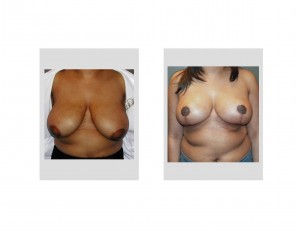
The appeal of breast reduction by liposuction is obvious offering essentially no scarring but also shorter operation times and even the ability to perform it under IV sedation or local anesthesia. Because liposuction does nothing to improve loose skin and the sagging breast, which almost every large breast has, it is only a rare procedure that I have offered in my practice as a primary method of breast reduction. The overwhelming majority of macromastia patients that I see need a breast lift in addition to breast tissue removal to both tighten the enveloping skin envelope and radically lift the nipple to a more central mound position.
However, for a few select patients that can accept keeping their existing degree of breast sagging (or it becoming even worse) then liposuction alone may be a reasonable breast reduction approach. Like male gynecomastia liposuction, how successful liposuction is depends on the fat vs. glandular component of the breast. The more fat tissue that is in the breast, the more effectively it can be removed and sculpted. Lumpy, firm and very glandular breasts do not reduce and sculpt as well.
Breast liposuction is done similarly to any other body area. The breasts are initially infused with a tumescent solution for bleeding/bruising control and to make the cannula slide through the tissues easier. The key to a good result is multidirectional liposuction. This means coming from at least two directions, usually with an entrance site from close to the axilla and one from the lateral end of the inframammary fold. There is no reason to be close to the skin when suctioning and given the size of the breast mound an aggressive approach can be used.
An interesting and relevant question is whether liposuction of the breast produces calcifications that can be seen in mammograms. Studies have shown that breast liposuction does not create such calcifications and that the internal scarring created from the procedure did not make it more difficult to detect breast cancer.
The most common use of liposuction in breast reshaping, however, is when it is combined with a traditional breast reduction technique. Most women are not aware that the fullness and heaviness that wraps around the side of the breast into the back will not be improved by the reduction-lift procedure. This is a discovery often made afterwards much to the patient’s dissatisfaction. This extra tissue is not part of the breast mound but a part of the chest wall. This is an issue that I discuss before breast reduction surgery and give the patient a choice of whether to have it done concurrently.
Dr. Barry Eppley
Indianapolis, Indiana


